
The Dust Bowl was the result of a period of severe dust storms that greatly damaged the ecology and agriculture of the American and Canadian prairies during the 1930s. The phenomenon was caused by a combination of natural factors and human-made factors: a failure to apply dryland farming methods to prevent wind erosion, most notably the destruction of the natural topsoil by settlers in the region. The drought came in three waves: 1934, 1936, and 1939–1940, but some regions of the High Plains experienced drought conditions for as long as eight years. It exacerbated an already existing agricultural recession.

Cimarron County is the westernmost county in the U.S. state of Oklahoma. Its county seat is Boise City. As of the 2020 census, its population was 2,296, making it the least-populous county in Oklahoma; and indeed, throughout most of its history, it has had both the smallest population and the lowest population density of any county in Oklahoma. Located in the Oklahoma Panhandle, Cimarron County contains the only community in the state (Kenton) that observes the Mountain Time Zone. Black Mesa, the highest point in the state, is in the northwest corner of the county. The Cimarron County community of Regnier has the distinction of being the driest spot in Oklahoma ranked by lowest annual average precipitation, at just 15.62 inches; at the same time, Boise City is the snowiest location in Oklahoma ranked by highest annual average snowfall, at 31.6 inches.

Seward County is a county of the U.S. state of Kansas. Its county seat and largest city is Liberal. As of the 2020 census, the county population was 21,964. The county was formed on March 20, 1873, and named after William Seward, a politician and Secretary of State under Abraham Lincoln and Andrew Johnson.

Morton County is a county in the southwestern corner of the U.S. state of Kansas. Its county seat and largest city is Elkhart. As of the 2020 census, the county population was 2,701. The county was named after Oliver Morton, the 14th governor of the state of Indiana.
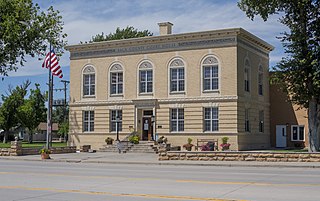
Baca County is a county located in the U.S. state of Colorado. As of the 2020 census, the population was 3,506. The county seat is Springfield. Located at the southeast corner of Colorado, the county shares state borders with Kansas, New Mexico, and Oklahoma.

Clayton is a town in and the county seat of Union County, New Mexico, United States. As of the 2010 census, the city population was 2,980.

Beaver is a town and county seat in Beaver County, Oklahoma, United States. The community is in the Oklahoma Panhandle. As of the 2020 census, the town’s population was 1,280. The city is host to the annual World Cow Chip Throwing Championship. Held in April, "Cow Chip" brings attention from nearby cities with a parade, carnival, and cowchip throwing.

Boise City is a city in and the county seat of Cimarron County, in the Panhandle of Oklahoma, United States. The population was 1,166 at the 2020 census, a decline of 7.9 percent from 1,266 in 2010.

The Farm Security Administration (FSA) was a New Deal agency created in 1937 to combat rural poverty during the Great Depression in the United States. It succeeded the Resettlement Administration (1935–1937).
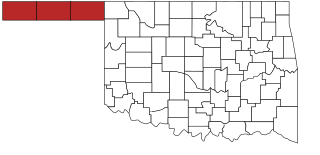
The Oklahoma Panhandle is a salient in the extreme northwestern region of the U.S. state of Oklahoma. Its constituent counties are, from west to east, Cimarron County, Texas County and Beaver County. As with other salients in the United States, its name comes from the similarity of its shape to the handle of a pan. Its largest city is Guymon in Texas County. Black Mesa State Park, located in Cimarron County, is the highest point in the state. Other points of interest include Beaver Dunes Park, Optima Lake, and the Optima National Wildlife Refuge. Oklahoma Panhandle State University is ten miles away from Guymon.
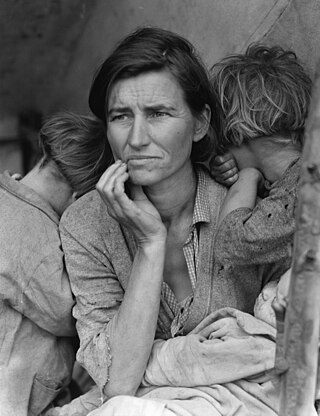
A pea-picker is a derogatory reference to poor, migrant workers during the Great Depression. These people were unskilled, poorly educated workers, employable only in menial jobs, such as harvesting crops and, as such, received poor wages for working long hours under dreadful conditions. Some of these people were photographed by Dorothea Lange.
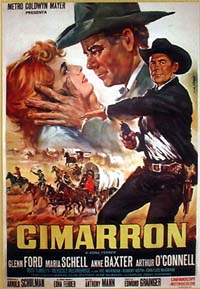
Cimarron is a 1960 American epic Western film based on the 1930 Edna Ferber novel Cimarron. The film stars Glenn Ford and Maria Schell and was directed by Anthony Mann and Charles Walters, though Walters is not credited onscreen. Ferber's novel was previously adapted as a film in 1931; that version won three Academy Awards.
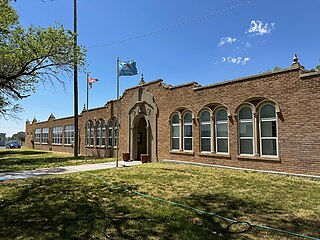
Felt is a small unincorporated community and census-designated place (CDP) in Cimarron County, Oklahoma, United States. As of the 2020 census, the town’s population was 77. It was named for C.F.W. Felt of the Santa Fe Railroad. Nearby is the Cedar Breaks Archeological District, included on the National Register of Historic Places listings in Cimarron County, Oklahoma. The community is served by a post office and a school. During the Great Depression in 1936 a farm in Felt was the site of the iconic Dust Bowl photograph titled Farmer and Sons Walking in the Face of a Dust Storm.
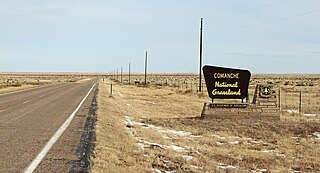
Comanche National Grassland is a National Grassland located in southeastern Colorado, United States. It is the sister grassland of Cimarron National Grassland and contains both prairie grasslands and canyons. It is separated into two sections, each operated by a local ranger district, one of which is in Springfield and the other of which is in La Junta. The grassland is administered by the Forest Service together with the Pike and San Isabel National Forests, and the Cimarron National Grassland, from common headquarters located in Pueblo, Colorado.

Arthur Rothstein was an American photographer. Rothstein is recognized as one of America's premier photojournalists. During a career that spanned five decades, he provoked, entertained and informed the American people.

Dust Bowl Ballads is an album by American folk singer Woody Guthrie. It was released by Victor Records, in 1940. All the songs on the album deal with the Dust Bowl and its effects on the country and its people. It is considered to be one of the first concept albums. It was Guthrie's first commercial recording and the most successful album of his career.

Black Sunday is a particularly severe dust storm that occurred on April 14, 1935, as part of the Dust Bowl in the United States. It was one of the worst dust storms in American history and caused immense economic and agricultural damage. It is estimated that 300 thousand tons of topsoil were displaced from the prairie area.

Arvin Federal Government Camp, also known as the Weedpatch Camp or Sunset Labor Camp, was built by the Farm Security Administration south of Bakersfield, California, in 1936 to house migrant workers during the Great Depression. The National Register of Historic Places placed several of its historic buildings on the registry on January 22, 1996.
The Last Man Club was a mutual support group for farmers that chose to stay in the Southern Plains of Texas, US in spite of the devastation caused by the Dust Bowl disaster of the 1930s. It was the first American Dream.
Caroline Henderson (1877–1966) was an American school teacher, farmer and author during the Dust Bowl. Born Caroline Boa in Wisconsin and raised in Iowa, she attended Mount Holyoke College, graduating in 1901. After teaching in Iowa until 1907, she relocated to Texas County in the Oklahoma Panhandle. She married local farmer Bill Henderson in 1908, the same year she bought a 160-acre farm near Eva, Oklahoma. Caroline and Bill had one daughter, Eleanor, born in 1909.


















